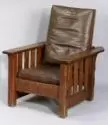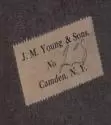An Army of Imitators

Last week, however, I did also take the time to complete my latest column for the next issue of American Bungalow magazine, whose staff has generously granted me the space and the latitude to explore any number of topics that float through my mind.
This, I have decided, must be one of the signs of growing older, as it is a far cry from my early days as a columnist for Country Living magazine, when writing assignments would be sent down from high atop the Hearst offices on Manhattan’s West 57th Street. It was during my tenth year writing “Antiques Across America” that my last (and still uncompleted) assignment came.
“Can you write your next column,” the chirpy young assistant to the assistant associate editor asked, “on potato mashers?”
It was time to move on.
In my American Bungalow columns I often return to a familiar theme of mine, that our appreciation for all things Arts and Crafts will grow in proportion to how much we learn about the craftsmen and craftswomen who designed and created the objects we love. It has been a theme that has influenced the majority of my choices of seminar topics at the annual Grove Park Inn Arts and Crafts Conference, for there is a story behind every piece we collect.
We just have to find it.

As I was preparing my own seminar for this past Arts and Crafts Conference, I once again found myself pointing out that the Arts and Crafts movement did not end with Gustav Stickley’s bankruptcy in 1916, but was carried on into the 1940s, citing the work of J. M. Young & Sons.
The Youngs were a family of furniture makers living in Camden, New York, a small town just north of Syracuse, where Gustav Stickley lived and worked. Like Stickley, John M. Young first made Victorian furniture, and did so well that two of his four sons — George and Clarence — learned the trade and eventually assumed responsibility for the family business.
And when the Youngs saw how well Gustav was doing in 1901 with his new line of Arts and Crafts furniture, they added their own line as well. Disciples of Gustav Stickley are quick to point out that rather than hire professional designers, as Gustav had done with George Wilkinson and Lamont Warner, the Youngs simply made their own version of Stickley’s furniture.
Their success may well have irritated Gus, who in 1912 complained about his “army of imitators,” for John Young and his two sons could have taught Gustav Stickley an important lesson: do one thing and do it well.
John, George, and Clarence Young did not produce a magazine or write books. They did not attempt to start a school. They did not form a construction company. They did not open a branch office in Manhattan or lease a twelve-story building. They stayed home in Camden and did what they knew best: they made Arts and Crafts chairs, rockers, and settles.
And like Leopold Stickley, when the demand for Arts and Crafts did begin to wane, they adapted, and remained in business until 1979 — seven years after the date to which historians have assigned the beginning of the Arts and Crafts Revival with the opening of the landmark Princeton exhibition entitled “The Arts and Crafts Movement in America, 1876-1916.”
Don’t you love the irony?

Until next Monday,
Thanks for stopping by!
Bruce
